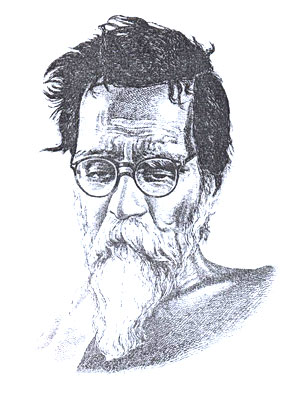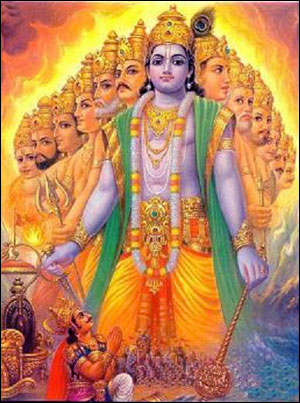 |
 |
 |
| Volume
3 - Issue 4 APRIL 2005 |
COSMIC
FORM Vinobaji (1895-1982) was a spiritual visionary of India, whose spirituality had a pragmatic stance with intense concern for the deprived. He was a brilliant scholar who could make knowledge accessible to ordinary people. He was Gandhiji's ardent follower, who could retain originality in thinking.
In the same way, the same beauty and holiness that there is in the cosmic form of the Lord is also present in the little image. If I am not able to recognise wheat when I am shown a handful of it, of what use is it to put before me a sackful! If I do not recognise Him in the little models before me, how can I recognise Him in all His vastness? Does size make any difference? To understand the small form is to understand the big. Hence, I feel no desire that the Lord should show to me His cosmic form. Nor have I, like Arjuna, the right to ask for it. Moreover, it is not as if what is seen by me is only a part of the cosmic form. If someone brought a part torn off from a picture we cannot imagine from it the whole picture. But the Lord is not made up of parts in this way; one of Him cannot be cut off from the rest. Even in a little image, the whole of that infinite Supreme is contained. What is the difference between a small photograph and a big one? Everything that is found in the big one is found in the small too. The small one is not a portion, a fragment of the big. A letter means the same whether it is written big or it is written small. This is the meaning behind image-worship. Many people have opposed image-worship. Foreigners, and even thinkers of our own country, have found fault with it. But the more I think of it, the more I realise its beauty. What is the meaning of it? Image-worship is the Vidya, the art of experiencing the whole universe in a little object. Is it wrong to learn the Vidya which helps us to see the whole world in a little village? This is not mere imagination; it is a matter of direct experience. What there is in the cosmic form, all of it is contained in a little image, in a grain of sand. In that lump of clay is everything - the mango, the banana, wheat, gold, copper, and silver. All the world is in that grain of sand. Just as an actor in a small troupe appears again and again on the stage taking different roles, the Lord appears in the universe. Like a playwright who writes his own play and himself takes all the parts in it, the Lord produces a play without end, and Himself acts playing the parts of countless characters on His stage. If we understand one chapter in this infinite drama, we shall understand them all.
It is because the Lord is present in every object through a distinct quality, that we find joy in it, we feel at one with it. This joy is not without a cause. Why do we feel joy? We are somehow related to it, and hence the joy. The mother's heart dances at the sight of her child, because she knows the kinship. The Lord in me is also in the object. To strengthen this kinship is to increase joy. There is no other means for joy. Begin to establish the link of love everywhere, and then watch the miracles happen. You will see then in every grain and every drop the Lord who pervades the boundless universe. When we have the power to see this, what else do we need? For this, however, it is essential to discipline and train the senses. When the desire for enjoyment goes and the holy outlook of love is gained, then we shall see God alone in all objects. This idea is described beautifully in the Upanishads. What is the colour of the Atman? What can we say about this? The Rishi says with love, '"yathaa ayam indragopah." The Atman is like this scarlet silk-soft insect the Indragopa. When one looks at the Indragopa, what joy there is! What is the source of this joy? That which exists in me, exists in the Indragopa too. If there is no kinship between us, how could there be joy? The beautiful Atman within me is within the Indragopa too. Why do we find joy in comparison? Why do we use similes? Why do we find joy in them? We use similes because things are alike, and we find joy in the likeness. If the things compared have nothing in common, where is the joy in it? If someone says that salt is like pepper, we should think him mad. But if someone says that the stars are like flowers, we see the likeness and enjoy it. When we say, "Salt is like pepper," we do not experience the likeness, but to one whose vision has become wide enough to see the same Lord in the salt and in the pepper, the question, "What is salt like?" and the answer, "It is like pepper," will bring an experience of joy. The warp and the woof of all the objects in the world is the Lord's form. To see it, where is the need for the vision of the cosmic form? (Extracted from Talks on the Githa by Vinobaji) |
| Optimized for Netscape and Firefox. Best viewed in Internet Explorer - 1024 x 768 resolution. |
 There
is a chapter called Viswaroopa Sandarshana Yoga in the Bhagawath Githa.
In the chapter is found a beautiful and entrancing description of
the Divine Cosmic form. Though all this is true, I am not particularly
drawn to this Vishvarupa, the cosmic form. I am quite satisfied with
a small image. I have learned to enjoy the sweetness of the small
and common but beautiful image before me. The Lord is not cut up into
little parts. It does not seem to me that the form of the Lord that
we can see is only a part of Him and that the rest is left out; but
I see that the Lord who pervades this vast universe is present in
His fullness in the little image, in the grain of sand. There is no
question of greater or less. The sweetness of the ocean of nectar
is found in every drop of it. I have got a tiny little drop of Amrita
(nectar of immortality); I feel that I should enjoy forever the sweetness
of that drop. I chose the example of Amrita, and not of milk or water,
on purpose. A cup of milk is just as sweet as a pitcher of it; but
though the taste is the same, the nutritive power is different. But
there is no difference between a drop of Amrita and a cup of it. Not
only the sweetness but the nourishment is the same in the sea of nectar
and in a drop of it. If we drink one drop of it, we gain the fullness
of Amritatva, immortality.
There
is a chapter called Viswaroopa Sandarshana Yoga in the Bhagawath Githa.
In the chapter is found a beautiful and entrancing description of
the Divine Cosmic form. Though all this is true, I am not particularly
drawn to this Vishvarupa, the cosmic form. I am quite satisfied with
a small image. I have learned to enjoy the sweetness of the small
and common but beautiful image before me. The Lord is not cut up into
little parts. It does not seem to me that the form of the Lord that
we can see is only a part of Him and that the rest is left out; but
I see that the Lord who pervades this vast universe is present in
His fullness in the little image, in the grain of sand. There is no
question of greater or less. The sweetness of the ocean of nectar
is found in every drop of it. I have got a tiny little drop of Amrita
(nectar of immortality); I feel that I should enjoy forever the sweetness
of that drop. I chose the example of Amrita, and not of milk or water,
on purpose. A cup of milk is just as sweet as a pitcher of it; but
though the taste is the same, the nutritive power is different. But
there is no difference between a drop of Amrita and a cup of it. Not
only the sweetness but the nourishment is the same in the sea of nectar
and in a drop of it. If we drink one drop of it, we gain the fullness
of Amritatva, immortality. The
basis of image-worship is the same as that of metaphors and similes
in poetry. When we see a circle or a sphere we are filled with joy,
for there is an order, a shapeliness in it. This shapeliness is a
divine quality. The Lord's creation is beautiful in all its parts
and relations. There is perfect harmony in it. The sphere is an image
of the shapeliness of the Lord. But even so is the twisted tree in
the undergrowth of the forest. There is in it the freedom of the Lord.
This tree knows no bondage. Who can bind the Lord? The Lord who is
beyond all bonds is in that contorted, unshapely tree. A tall straight
column reminds us of the Lord. In the highly wrought ornamented pillar
we see the Lord who has painted the sky with stars. In a well-trimmed
garden we see the restraint of the Lord and in the primeval forest
we see His grandeur and freedom. In both we find joy. Are we then
mad? No, there is joy in both, because there is in each a quality
of the Lord. The power in the smooth Salagram is also in the rough
Linga taken from the Narmada. Hence, if I do not see the form of the
Lord in all its majesty, it does not matter.
The
basis of image-worship is the same as that of metaphors and similes
in poetry. When we see a circle or a sphere we are filled with joy,
for there is an order, a shapeliness in it. This shapeliness is a
divine quality. The Lord's creation is beautiful in all its parts
and relations. There is perfect harmony in it. The sphere is an image
of the shapeliness of the Lord. But even so is the twisted tree in
the undergrowth of the forest. There is in it the freedom of the Lord.
This tree knows no bondage. Who can bind the Lord? The Lord who is
beyond all bonds is in that contorted, unshapely tree. A tall straight
column reminds us of the Lord. In the highly wrought ornamented pillar
we see the Lord who has painted the sky with stars. In a well-trimmed
garden we see the restraint of the Lord and in the primeval forest
we see His grandeur and freedom. In both we find joy. Are we then
mad? No, there is joy in both, because there is in each a quality
of the Lord. The power in the smooth Salagram is also in the rough
Linga taken from the Narmada. Hence, if I do not see the form of the
Lord in all its majesty, it does not matter.